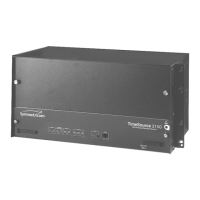Chapter 1 Overview of the TimeSource 3100
Functional Description
28 TimeSource 3100 User’s Guide 097-72020-01 Revision K – December 2005
Bridging/Holdover Behavior
In the TimeSource 3100, alarms are designed with a built-in hysteresis. This means
that an alarm is not announced as soon as some error condition is detected. There
is a pre-integration time during which the error must persist in order for the alarm to
be announced. On the flip side, the error must be clear for a certain time for an
alarm condition to be cleared. This ensures that intermittent conditions are not
flagged unnecessarily.
During the normal working of the TimeSource 3100, it is a very common occurrence
that the GPS satellites may not be visible during certain parts of the day, depending
on the installation of the antenna. This is particularly true with wall and, especially,
window antenna installations. The TimeSource 3600 has been designed to work
around this situation.
The TimeSource 3100 enters “Bridging” mode when all satellite locks are lost.
There is no TL1 annunciation that the system has entered “Bridging” mode. This is
“Non Service Affecting” and the outputs are not affected. The system runs off its
internal oscillator and the outputs are kept within the G.811 PRS mask by the
BesTime engine.
When “Bridging” mode persists for more than 30 minutes, the system enters
“Holdover” mode and a “Holdover” event is generated. This may or may not affect
the outputs depending on the alarm integration parameters that can be set by the
user.
The system allows the user to set various parameters for GPS error, Holdover error,
and SPAN error conditions. These parameters are:
Initial Severity
Initial Service Affecting state
Integration Time
Final Severity
Final Service Affecting state
The system also allows the user to set a parameter to define how outputs should
behave in an alarm condition. Outputs can be set to AIS, Squelch, or SSM on an
alarm. Outputs can also be set to ignore alarm conditions.
When the “Holdover” event is announced, it is announced with the Initial Severity
and Initial Service Affecting state. If the “Holdover” event persists for the length of
the Integration Time, the alarm is escalated to the Final Severity and Final Service
Affecting state.
The “Holdover” event/alarm is cleared when the satellites are visible again.

